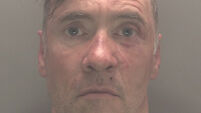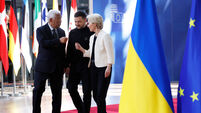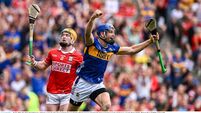Blockbuster’s author embroiled in unholy row
The accusation was made in a breach of copyright lawsuit filed against “The Da Vinci Code” publisher Random House. If the lawsuit succeeds in getting an injunction barring use of the disputed material, the scheduled May 19 release of The Da Vinci Code film starring Tom Hanks and Ian McKellan could be threatened.
Michael Baigent and Richard Leigh, authors of the Holy Blood and the Holy Grail, sued Random House, which also published their book. Random House has denied the claim.
Baigent and Leigh claim Brown appropriated their ideas and themes in writing his book, which has sold more than 25 million copies worldwide since its 2003 publication.
Both books hinge on the theory that Jesus married Mary Magdalene and they had a child, and that blood line survives to this day. The earlier book set out the notion that Christ did not die on the cross but lived later in France.
Brown, who was expected to testify next week, told reporters outside court that this idea had no appeal for him.
“Suggesting a married Jesus is one thing, but questioning the Resurrection undermines the very heart of Christian belief,” said Brown, who described himself as a committed Christian.
Jonathan Rayner James, a lawyer for Baigent and Leigh, said the case did not relate to the theft of specific parts of text but to the appropriation of themes and ideas.
“Brown copied from The Holy Blood and the Holy Grail and therefore the publication of the resulting novel is an infringement of my clients’ copyright,” he told the court.
James said his case was not an attempt to “stultify creative endeavour” or claim a monopoly on ideas or historical debate.
But Jonathan Baldwin, representing Random House, said Baigent and Leigh were making “wild allegations.”
He said they were suggesting that “Mr Brown has appropriated not only the numerous parts of a jigsaw puzzle but the organisational way (Baigent and Leigh) put it together.”
“In brief, the complaint appears to be that The Holy Blood and the Holy Grail discloses the idea that Jesus was married to Mary Magdalene, that they had children which survived and married into a line of French kings, that the lineage continues today, and that there is a secret society based in France which has the objective of restoring this lineage to the thrones not only of France but to the thrones of other European nations as well, and that (The Da Vinci Code) uses some of this idea,” Baldwin said.
He said Brown referred to “The Holy Blood and the Holy Grail” in his novel, but the earlier book “did not have anything like the importance to Mr Brown which the claimants contend it had.”
The case is being heard in the Royal Courts of Justice on The Strand, a short walk from the Temple Church, which figures in Brown’s book. The church, founded by the Knights Templar, has reported an increase in visitor traffic inspired by The Da Vinci Code.
Brown’s book also was the target of a previous US lawsuit. In 2005, a judge in New York ruled that his book did not infringe on the copyrights of Daughter of God, by Lewis Perdue. The judge also ruled out any copyright violations of Perdue’s 1983 novel The Da Vinci Legacy.
The big-screen adaptation of the best-selling book The Da Vinci Code, starring Tom Hanks, is set to be delayed by the legal challenge.
The film, directed by Oscar winner Ron Howard, was due to be released in Britain on May 19.
If the judge upholds the claim, there could be a lengthy delay or even ban on the film, which is expected to be one of the year’s biggest movie hits.
A prominent Catholic priest has called for Catholics to boycott the feature film.
Father John Trigilio, president of the Confraternity of Catholic Clergy, said: “I am asking my parishioners and Catholics everywhere to boycott the film and any of its advertising sponsors.
“The Da Vinci Code is offensive, sacrilegious, blasphemous and historically inaccurate.
“While those who proclaim ‘it is only fiction’ forget that any and all written words have an impact on the reader; and erroneous conclusions based on imaginary premises can and often do lure many readers to accept and believe as true what their normal common sense and ordinary human reason tell them is utter nonsense.”














